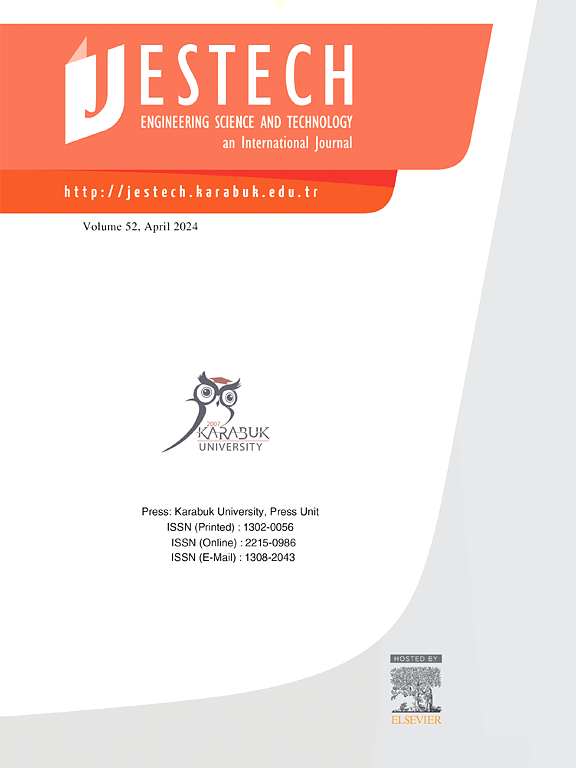Improved UWB-based indoor positioning system via NLOS classification and error mitigation
IF 5.1
2区 工程技术
Q1 ENGINEERING, MULTIDISCIPLINARY
Engineering Science and Technology-An International Journal-Jestech
Pub Date : 2025-02-13
DOI:10.1016/j.jestch.2025.101979
引用次数: 0
Abstract
Non-Line-of-Sight (NLOS) conditions in indoor positioning systems significantly degrade positioning accuracy. Although Ultra-Wideband (UWB) technology is renowned for its high precision in Line-of-Sight (LOS) environments, under NLOS conditions, positioning errors typically exceed 30 cm. To address this issue, we propose a method for identifying and classifying NLOS signals based on Support Vector Machine Recursive Feature Elimination (SVM-RFE). We extract multiple features from the UWB Channel Impulse Response (CIR) and perform correlation analysis using the Pearson Correlation Coefficient (PCC) to select the most discriminative features via the SVM-RFE algorithm. The classification results are then utilized within an Adaptive Robust Extended Kalman Filter (AREKF) to establish an error model for mitigation. The proposed method was evaluated using both a public dataset from Ghent University and a locally collected dataset. On the public dataset, the SVM-RFE algorithm achieved classification accuracies of 97.6% in the hallway environment and 96.6% in the office environment, outperforming transfer learning (TL) deep neural networks (DNNs) tested on the same dataset. To further validate the robustness of the algorithm, experiments on the locally collected office dataset demonstrated a classification accuracy of 97.2%. In terms of distance measurement error mitigation, the proposed AREKF algorithm reduced errors at the 95th percentile by 70% and 75% in two different environments compared to transfer learning methods on the same public dataset. When tested on the locally collected dataset, the positioning error of the AREKF was significantly lower than that of other mainstream algorithms, highlighting the practical advantages of the proposed method.
求助全文
约1分钟内获得全文
求助全文
来源期刊

Engineering Science and Technology-An International Journal-Jestech
Materials Science-Electronic, Optical and Magnetic Materials
CiteScore
11.20
自引率
3.50%
发文量
153
审稿时长
22 days
期刊介绍:
Engineering Science and Technology, an International Journal (JESTECH) (formerly Technology), a peer-reviewed quarterly engineering journal, publishes both theoretical and experimental high quality papers of permanent interest, not previously published in journals, in the field of engineering and applied science which aims to promote the theory and practice of technology and engineering. In addition to peer-reviewed original research papers, the Editorial Board welcomes original research reports, state-of-the-art reviews and communications in the broadly defined field of engineering science and technology.
The scope of JESTECH includes a wide spectrum of subjects including:
-Electrical/Electronics and Computer Engineering (Biomedical Engineering and Instrumentation; Coding, Cryptography, and Information Protection; Communications, Networks, Mobile Computing and Distributed Systems; Compilers and Operating Systems; Computer Architecture, Parallel Processing, and Dependability; Computer Vision and Robotics; Control Theory; Electromagnetic Waves, Microwave Techniques and Antennas; Embedded Systems; Integrated Circuits, VLSI Design, Testing, and CAD; Microelectromechanical Systems; Microelectronics, and Electronic Devices and Circuits; Power, Energy and Energy Conversion Systems; Signal, Image, and Speech Processing)
-Mechanical and Civil Engineering (Automotive Technologies; Biomechanics; Construction Materials; Design and Manufacturing; Dynamics and Control; Energy Generation, Utilization, Conversion, and Storage; Fluid Mechanics and Hydraulics; Heat and Mass Transfer; Micro-Nano Sciences; Renewable and Sustainable Energy Technologies; Robotics and Mechatronics; Solid Mechanics and Structure; Thermal Sciences)
-Metallurgical and Materials Engineering (Advanced Materials Science; Biomaterials; Ceramic and Inorgnanic Materials; Electronic-Magnetic Materials; Energy and Environment; Materials Characterizastion; Metallurgy; Polymers and Nanocomposites)
 求助内容:
求助内容: 应助结果提醒方式:
应助结果提醒方式:


